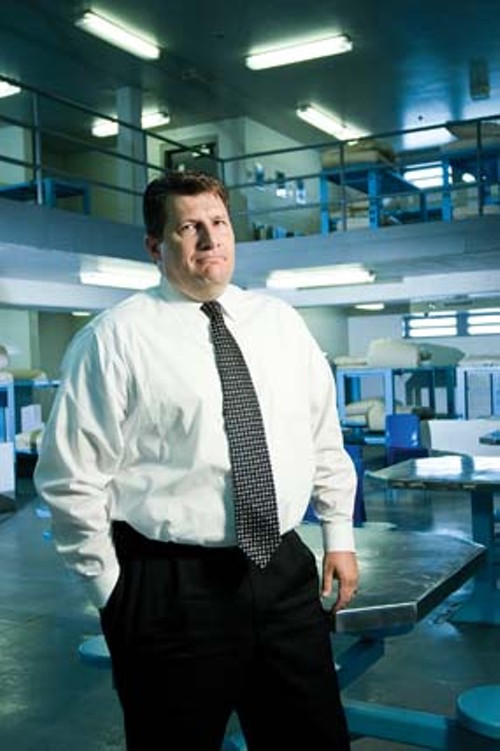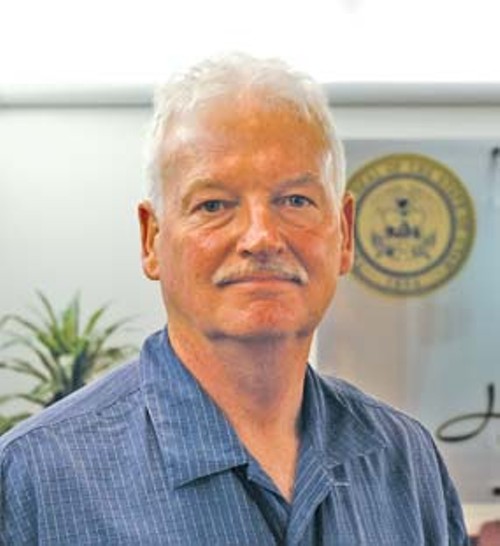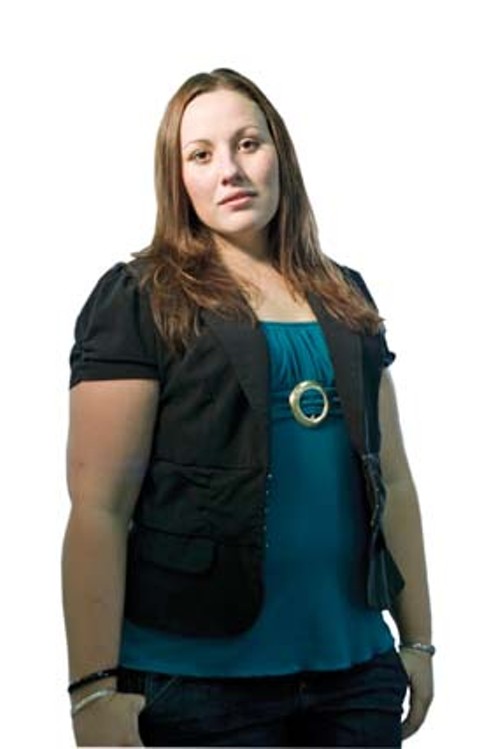Feature | Hard Labor: Too few drug-treatment options means too many pregnant addicts in Salt Lake County Metro Jail
By Eric S. Peterson @ericspetersonCrystal’s earliest memories were of betrayal and the destruction of trust. She says her older brother sexually abused her when she was 4, a scar she carried in silence all her life. It made mourning her brother’s early death when he was 17 an unemotional affair.
Two years later, her estranged father committed suicide by driving his car off a cliff. While her parents’ marriage had been abusive and frightening, Crystal at age 10, couldn’t stop blaming herself for their divorce. She would eventually learn her father cheated on her mother and fathered a child with a 15-year-old girl.
Her childhood had been turned upside down by lies, abuse and mistrust. Even birthdays in her family were harbingers of despair. “All the deaths in my family were around birthdays,” Crystal says, noting her father’s suicide two days before his birthday and her brother’s death four days before her birthday.
Crystal embraced drugs—the addiction, at least, wouldn’t abandon her. “How could it leave me? This was mine, and I could keep a hold of it.”
Crystal (City Weekly is using only her first name for reasons of confidentiality) went the way of many addicts, through a series of crimes and court dates. But, unlike many who roll through Utah’s 3rd District Court (which has jurisdiction over Salt Lake, Summit and Tooele counties), Crystal had more than herself to worry about. At age 22, she shared her hollowing methamphetamine addiction with her unborn daughter.
Being pregnant and addicted didn’t mean much to her at the time—except as an excuse to plead before a judge to avoid jail time. She hoped authorities would see that jail was not the place for an expectant mother.
Crystal was wrong. Seven months pregnant, she was sentenced to three months in the Salt Lake County Metro Jail on a grand-theft-auto conviction. She would give birth to her baby girl—as a county jail inmate—on Sept. 6, 2006.
Increasingly, judges are faced with what to do with pregnant defendants like Crystal. In sentencing the women, they struggle to balance the reality of limited jail space against months-long waiting lists for community drug-treatment programs. With treatment-center beds so hard to come by, judges hand pregnant women jail sentences to provide them at least with safety and some prenatal care. Judges know it’s a stopgap measure.
Some on the bench have sentenced certain drug-addicted mothers to longer terms than actually fit the crime. With no rehabilitation readily available, their thinking goes, jail might keep the women away from drugs long enough to allow their babies to be delivered with fewer complications. Though, realistically, most of the babies will be born into a world where drug withdrawal is one of their first sensations.
The Big House Maternity Clinic
Last spring, Salt Lake County Sheriff’s officials were pushing through a routine, weekly budget meeting with the County Council when they happened to mention that, of slightly more than 300 female inmates at the county jail, 20 were pregnant. Silence fell over the room as the sobering fact set in.
Since before that meeting, the Sheriff’s Office had begun tracking information on pregnant inmates and the ever-growing medical costs incurred by even this small segment of the jail population.
“It’s significant when you start talking about health care and the cost of delivery,” says Rollin Cook, corrections bureau chief for the county Sheriff’s Office. Cook and his staff are still gathering numbers on the trend of pregnant inmates but are concerned about what they’re seeing. With skyrocketing health-care costs everywhere, the jail’s infirmary struggles with adequate care for a population—male and female—that battles drug addiction and its devastating effect on inmates’ overall health.
“Speaking from a law-enforcement experience, a lot of us believe this is part of the meth problem,” Cook says. “Meth is eating these people from the inside out. [They’re] coming in with cancers they’ve never had before. Same with the women. Think about it—[for pregnant inmates] it is a very high-risk pregnancy.”
Still, the risks to these women on the street makes jail prenatal care a potential lifesaver—for mother and child. But for the Sheriff’s Office, constantly struggling with a facility considered a budgetary black hole, accommodating inmates at high medical risk strains their resources.
“The problem is the jail is really caught between a rock and a hard place,” Cook says. “Judges want [pregnant inmates] off the street because, when they’re on the street, they’re using drugs and putting their babies and themselves at risk. [But, at the same time,] the jail is trying to contain costs, and we’re trying to watch what happens with county taxpayer money. Sometimes we get put in the position of having to be the caretaker rather than the person responsible for the jail.”
Exact numbers are hard to extrapolate. One pregnant inmate could spend a week in jail and then come back to serve more time at the end of the same month. The nature of addiction and crime feeding off each other means some women make multiple trips to jail every year. Cook’s office estimates that the jail averages 21 pregnant inmates a month.
All of the women have access to University of Utah Medical Center for regular prenatal checkups, deliveries and abortions, but only if medically necessary (a taxpayer-funded elective abortion, even in the first trimester, is not a legal option). Inside the jail, doctors spend most of the week either on-call or making visits. On-site, full-time nurses make rounds throughout the jail performing checkups and distributing vitamins.
“Oftentimes, it’s better than anything they would receive on the outside, and that’s why judges want them in here,” Cook says. But the bills add up even for a small number of pregnant inmates (see "Bills From Behind Bars," page 4).
Sitting in Judgment
For 3rd District Court Judge Terry Christiansen, it never gets any easier to send a pregnant woman to jail. But a letter he once received, and which he has held onto ever since, convinced him it’s the right thing to do. The letter was a simple “thank you” from a young mother who had appeared before him in court. Christiansen had made sure she got cleaned up in jail. The woman credited Christiansen for saving her life. She named her child after him.
Christiansen says he has never over-sentenced a pregnant woman, though more than once he has set probation contingent on her getting and staying clean. The first time Christiansen made this ultimatum was in 2002. He told an addicted woman, “If you want to destroy yourself with drugs, that’s one thing, but your child, that’s another.”
| n
THE FIX n Patrick Fleming, director of Salt Lake County substance-abuse services Crystal, recovering addict Rollin Cook, Salt Lake County Sheriff’s Bureau of Corrections n For more discussion of dealing with addiction and criminal justice, the Salt Lake County will be holding meetings open to the public: n n The Salt Lake County Social Justice Master Plan: July 15, noon, Salt Lake County Government Center, 2001 S. State, Rm. 2003. n n Salt Lake County Criminal Justice Advisory Committee: June 26, noon; Aug. 28, noon, Salt Lake County Government Center, 2001 S. State, Rm. 2003. n |
“Treatment is obviously the best option,” Christiansen says. “If the person is not amenable [to treatment], I think that the court has little alternative but to do everything possible to have that individual incarcerated, most importantly for the child. That child is at the whim of the mother. If she abuses meth, cocaine or heroin, the last thing we want is to have a drug-addicted child born into the world.”
When juggling taxpayer dollars and inmate health care, sometimes the greatest costs are the ones hardest to calculate.
Since 90 percent of county jail inmates are released after a few months to a year, these inmates are soon back in the community. If they can’t get adequate drug rehab in jail and, if the community lacks residential treatment programs, paroled inmates stand a greater chance of spiraling down into addiction and crime—again. The rates of recidivism for inmates drifting back into drug use are often staggering. Without treatment in the jail or community, inmates are at least 50 percent likely to continue abusing drugs, and for addicts with more chronic habits, the rate can reach up to 90 percent, according to Patrick Fleming, director of Salt Lake County substance-abuse services.
Criminal Boot Camp
On her first night in the Salt Lake County Metro Jail, Crystal, then seven months pregnant, fell into a knockout sleep, the kind that comes after pushing the body and nerves for days through an inexorable rush, stoked by hit after hit of meth. Cut off from her fuel, Crystal slept, as if anchored to her bed. She would barely drag herself out of her bottom bunk (mandatory for pregnant inmates) to get her meals, then shuffle back to her cell and crash back into sleep.
Crystal’s first week in jail was in the fall of 2006, a short stint while prosecutors tried to get a grand-theft-auto charge to stick. She would be released after a week, only to return less than a month later on the same conviction—this time for three months
But for Crystal, county jail was hardly a wake-up call.
“Jail was always a way to catch up on sleep and eat,” Crystal says, adding, “but you also could get a new contact list.”
“There are at least 60 other cellies [in your block] so you have a whole new list when you get out,” she says.
Crystal took part in the jail’s offered treatment programs but admits she wasn’t serious about getting better. “Everyone is always like, ‘Oh, I want to change,’ but it’s just bullshit that we say.” Jail and its treatment program were timeouts from life at the feverish meth-injected intensity and the “running and gunning” of crimes Crystal and her gangster boyfriend took part in to support their habits.
Crystal and many others participated in the Salt Lake County Metro Jail’s CATS (Correctional Addiction Treatment Services) program. The program is considered a therapeutic community model—where inmates address one another’s addictions. The program has enjoyed success with many inmates and is highly regarded by those who work in criminal justice, including Christiansen. “I can’t tell you how many lives [the CATS] program has saved,” the judge says.
Some, however, question how efficient an institutional setting for treatment can be.
“The jail, over time, has become more about drug programs and training programs,” says Salt Lake County Councilman Mark Crockett. “But it’s still a relatively one-size-fits-all answer.”
Crockett is heading up the new county Social Justice Master Plan committee, tasked with examining treatment and other criminal-justice issues. Crockett’s priority is to increase treatment and opt for more sophisticated treatment programs to deal with different types of addicts.
“It has to be true for some lower risk people that some treatment programs can be more effective and cheaper in lower security environments,” Crockett says. “But jail is really expensive and it’s a boot camp for higher levels of crime.”
“It’s just a game in there, it really is,” adds Crystal. Whether it was people lying their way through treatment, playing cards and betting their commissaries or even the 60- and 70-year-old women swapping medications, jail, she says, offered an expansive network of fellow criminals.
Crystal did time with inmates from every walk of life: fellow gangsters, construction workers, business professionals, mothers and grandmothers.
Whether by offering new clients or hookups, the jail environment made Crystal a better-equipped junkie. “It’s just a new inner ring of people who you can get drugs from [when you get out].”
Beds vs. Bars
While criminal-justice experts grapple with a lack of both jail and treatment space, some believe there might be a solution for both issues, one that lies with the vacant Oxbow Jail at 3148 S. 1100 West, in South Salt Lake. The jail has been shut down since 2002. One might imagine the mothballed facility is crumbling away, but a recent tour suggests otherwise. A custodian with a heavy set of keys opens several doors and flips on light switches to reveal long, clean hallways, vacant guard stations with functioning surveillance cameras, and a kitchen stocked with clean ovens and baking equipment. The whole facility has the feel of an elementary school opened in summer just before school begins again: empty, but not decrepit.
“[Salt Lake County] Mayor [Peter] Corroon once asked me how fast we could get this back up and running,” Salt Lake County Sheriff’s Office’s Rollin Cook says. “I told him 48 hours if we needed to.” Last year, the state Criminal Justice Advisory Committee, made up of county government leaders, legislators and members of the judiciary, had unanimously pushed for Oxbow to reopen.
Corroon earmarked $700,000 for retrofitting the facility, but that money was diverted from the proposed budget by Crockett and shuttled into creating another panel—the Social Justice Master Plan committee. Its mission is to further study treatment and jail options.
The county jail now releases an estimated 600 to 800 inmates a month due to overcrowding. A frustrated Sheriff’s Office imagined Oxbow would be a win-win arrangement, with 560 new beds taking pressure off the main facility. At the same time, at least 200 of these beds would be available for drug treatment for lower security inmates.
Cook is willing to collaborate more with politicians and other stakeholders, but he questions the need for yet another committee. “I don’t mean for this to be a political answer,” Cook says. “But we’re always willing to partner with everybody to look for solutions. We really need action right now. We’ve done enough planning, we really need to start moving forward.”
County Sheriff Jim Winder has long lobbied to reopen Oxbow. He contends this would add another level of treatment in between the minimum-maximum security county jail and the community. It would also help court-ordered therapy succeed by having jail space for leverage against those who don’t comply with the terms of their sentence.
“You have to have jail beds that can act as a deterrent—as the hammer,” Cook says. “So that when somebody is in a treatment center there is a jail bed for them to go into or that threat of a jail bed. Right now we don’t even have that, people aren’t staying, it’s a revolving door of people getting booked in and going right back out.”
Cook, like others involved in treatment and criminal justice, recognizes that with an ever-expanding jail population and drug problem, the solution isn’t merely jail vs. treatment space.
“It’s a combination of both. And, right now, we don’t have either. We don’t have jail beds, and we don’t have enough treatment inside the facility or in the community to help out.”
The county currently contracts residential treatment with 16 agencies and 30 different programs in the valley. But Patrick Fleming, director of Salt Lake County substance-abuse services, sees the problem as just being too little of a good thing.
“We have 370 beds for residential and detox services and a four-month-long waiting list,” Fleming says. “People tend to re-offend when they wait that long.” Fleming intends on proposing the County Council earmark enough money to nearly double the county’s existing residential bed space, adding 320 more slots. Estimated price tag: $13 million. It’s a heavy investment, with Fleming acknowledging residential treatment isn’t a cure-all, but just another piece of the criminal-justice formula.
“The judges a lot of times don’t feel comfortable putting some [offenders] into community-based treatment,” Fleming says. “So they feel safer putting them into county jail. The piece that’s got to happen is that treatment starts when they are in jail and continues on when they are released into the community.”
This kind of holistic approach, Fleming says, means increasing continuous-treatment options, providing inmates with good job skills and finding them a place to land when they get out of jail.
Increasing the variety of community-treatment options, Fleming says, can help best match programming for different individuals, like addicted mothers.
“If you put a mom with two kids inside a county jail for a year, it will cost $30,000 and $32,000 for foster care for each child—and what you have is a family ripped apart, with all the socialization problems that come with it,” Fleming says. “Families are still the best way to raise kids, so how about if we just expand women’s treatment. Keeping a mom in treatment for a year, getting her vocational skills and in stable housing will run us about a third of the cost.”
The Breaking Point
When Crystal’s youngest, Karma, was born, the baby tested positive for methamphetamine at levels so high, doctors told her it was if she had been shooting up meth directly in the womb. After the delivery, the state Division of Child and Family Services removed the baby and placed her in foster care.
Crystal soon had her breaking point. Different factors collided, including a sobering realization that the game she had been playing her whole life was ruining her and that all her relationships were based on abuse and violence—from her older brother to her gangster boyfriend who raped and beat her. By age 23, she had given birth to two children yet had never really been a mom to either.
“When I was high, I knew I was [a good person] but my actions weren’t showing it,” Crystal says. “I knew I was different, I just had to prove to myself that I wasn’t going to be a junkie.”
| n
Bills From Behind Bars n
n Source: Salt Lake County Sheriff’s Bureau of Corrections n |
While finishing her last stint in jail, Crystal opted for residential treatment and was fortunate to land in an empty slot at the Odyssey House’s women and children’s program in Salt Lake City. Crystal believes it wasn’t just luck that got her into that program; it was meant to be.
Once a teen mom who sold her firstborn’s diapers for drug money, Crystal is now a few months shy of graduating from treatment and is the house supervisor for the center’s other 12 moms. For the past 16 months, she has slowly worked through the steps of treatment, learning all the skills she never picked up at her own home: how to change her bed, make breakfast, getting her daughter ready for school.
During the day, Crystal takes classes on balancing a budget, job-interviewing skills and writing a résumé. Every second of the day is managed to push down an addiction that once was the only thing she knew.
Crystal says she realizes that wrestling with addiction requires help, and from jail to community treatment, she was lucky enough to have spent almost two years in various levels of rehabilitation. It’s a regimen that most likely has saved her life and has allowed her to reunite with her two children. Her oldest child, Brianna, has been through therapy in the Odyssey House program. Crystal says Brianna has learned to forgive her mom for a childhood forsaken by meth.
The biggest quandary in a story like Crystal’s—and there are hundreds of them—lies in the gulf between jail and the community. Getting clean is a tremendous challenge, and people in the corrections business know it. Sending a newcomer to jail doesn’t always scare her straight. And, for those who want help when they get out of jail, waiting for months to start treatment is usually far too long.
Whether the solution lies in opening Oxbow to place more treatment-amenable inmates in an environment separate from the more hardcore criminals at the county jail, expanding and diversifying community treatment, or both, a growing population of addicts like Crystal are likely to need more help.
“I’ve gotten a chance to start completely over. I’m not that horrible drug-addict person anymore,” Crystal says. Then, quietly but very certain, she adds: “I’m a mom now.”
More by Eric S. Peterson
-
The Secret Sauce
How Utah lawmakers disclose—or don't disclose—conflicts of interest.
- Feb 14, 2024
-
Police departments in Salt Lake County spent almost $20 million on civil rights complaints in the past decade
The Co$t of Mi$conduct
- Oct 18, 2023
-
Women decry harassment and toxic culture at St. George auto dealership
Men at Work
- Oct 11, 2023
- More »
Latest in Cover Story
Readers also liked…
-
Forget the family pedigree—Robert F. Kennedy Jr should not be the next president of the United States
Trojan Horse
- Jun 21, 2023
-
Women decry harassment and toxic culture at St. George auto dealership
Men at Work
- Oct 11, 2023











